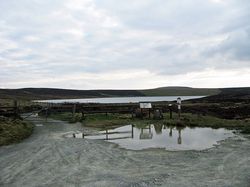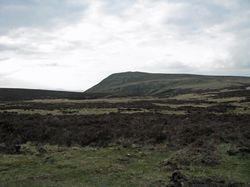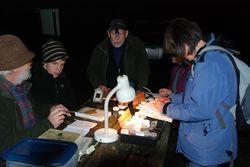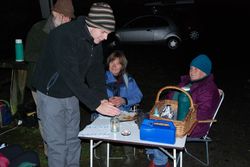Click the event location to view the species recorded
| 07/04/12 - Dolforwyn Woods Nature Reserve - SO155958 Our
first event of the year was at Dolforwyn Woods. It was a joint event
with Montgomeryshire Wildlife Trust who were having a ‘Bio Blitz’ at
the site, this evening and the following Saturday. During this event
they were concentrating on bats in particular, but general recording of
other wildlife was also taking place. Two species of bats were recorded
during the evening, the Common Pipistrelle and the Soprano Pipistrelle. As for mothing, the traps went on at dusk and it wasn’t long before the first species was brought to the table, a Chestnut. This was quickly followed by a Common Quaker and an Early Thorn, and both melanic and normal forms of Engrailed were also taken during the evening. The most numerous species was the Brindled Pug, and again both the dark and normal forms were recorded. Other common species to make a show included the Hebrew Character and Twin-spotted Quaker. Strangely the Small Quaker which is normally a common species was only found in low numbers. Early flying geometrids recorded included, Purple Thorn, Shoulder Stripe, Streamer, a rather early Yellow-barred Brindle and a stunningly fresh Water Carpet. The star of the night was a fabulous Great Prominent, a good crowd puller, as always. The best record of the evening was the local Oak Nycteoline, a species with patchy distribution in the county. As always, a flurry of late species turned up as we started to pack the traps away, these were, Frosted Green, Oak Beauty, Early Grey and Red Chestnut. No migrant species were recorded during the session. Unfortunately the only two species of micro moths found were, Eriocrania subpurpurella and Diurnea fagella. I had hoped that more micro species would have been recorded, but there we are, that’s the nature of mothing, you just never can tell what will show up. The weather stayed fine throughout the event and I’m sure that everyone went home content, having seen (or heard) a good helping of flying creatures, whether it was moths or bats! | ||||
05/05/12 - Lake Glaslyn - SN831943
After a short while the first moth was spotted flying by HQ, it was quickly apprehended and turned out to be a rather smart Red Chestnut. As time went on (and the temperature went down!) it was clear we weren’t going to be wading through vast numbers of moths desperate to reach the traps. In a flurry of activity a couple of moths were spotted next to HQ, we quickly had them in pots but they turned out to be more Red Chestnut, perhaps giving themselves up in the hope of spending the night in a nice warm pot away from the wind. One observation we made was that the Red Chestnuts we recorded were all very fresh: interesting as the moth was reaching the end of its flight season. As a sign of the poor mothing, a rather spectacular black slug was spotted on the ground which amused us for a while. Black Grouse were also out and about on the reserve as we heard them calling throughout the event. As the night drew on, it seemed the cold was getting to us; Peter was adamant that he had seen a moth flying into one of the traps. However a thorough search took place yielding no such moth, perhaps hallucinations are a symptom of hyperthermia?
When Peter seemingly hallucinated a second moth we thought it was about time to pack up, with temperatures at a bone-chilling 3.5°C. We checked through the traps one last time; nothing! It seemed to be the only MMG event where not a single moth has entered the traps! We were glad we packed up when we did; as we left the reserve the heavens opened. Despite the poor mothing (2 species of 5 moths), I can confidently say we all had a very enjoyable evening, with the usual banter, good company and cake keeping us going! Douglas | ||||
| 02/06/12 - Llyn Mawr - SO012970 During the day of the event the weather was overcast with the odd light speckling of rain, basically, pretty good trapping conditions – well, that’s what we thought at the time, but things don’t always turn out as expected seem, do they! Douglas wasn’t able to get a lift to Llyn Mawr so he had caught a train over to my place so that he could travel with me. As we set off, the weather, as I have said, looked ‘well set’, but as we started to climb into the uplands towards the site conditions deteriorated very quickly and by the time we reached the lake we could hardly see 25m in front of us, due to the low cloud. At this time, it was still dry, but as soon as the traps were set up, the rain started and it hardly relented throughout the evening. Fortunately, we managed to raise the gazebo before the heavy rain, so at least we were provided with a dry retreat! During our recky to decide where to place the traps Douglas noticed a couple of micro moths in the grass which we didn’t name at the time, and alas, due to the weather they were not seen again, so, apart from a worn unidentifiable Agonopterix, these were the only two micro moths that were seen all evening! However, despite the conditions, we did record a small, but steady, stream of macro moths throughout the evening. First to show was a Devon Carpet followed by a Brown Silver-line. The latter along with the Flame Shoulder were by far the most numerous species we saw throughout the event. After about an hour I nipped back to the car for my wellington boots, as by this time the wet was beginning to soak up my trousers (not very pleasant). When I returned, Douglas said ‘we’ve got a Hawk Moth’. I was very surprised to hear that it was a Lime-hawk as this is not a species normally associate with higher altitude, so it was a very good record for this site. A short while later however, we did record a species which was in its right environment, a Glaucous Shears – this species had not been recorded in the county for many years until last year, when several were recorded from around the county; it was good to see it again this year. The white sheet proved once again to be an excellent way to draw in the moths as most of the evening’s species were found on it. Soon after midnight we decided that we had got wet enough and that it was time to pack up, so, in the driving rain we checked the traps one last time and packed them away. While doing this we recorded a late flurry of species which included Ruby Tiger, White Ermine and Pebble Prominent. With most of the (wet) kit packed up, the gazebo was the last job to tackle, but as we did this, Douglas notice a Grey Pug on the roof. This was our only pug species of the night, but it still wasn’t our last species, just as we were about to leave we saw a nearly full grown Drinker Caterpillar on the fence post; a beautiful creature in its own right – this was definitely to be our last species of the night, the kit was now in the car, we were going home, leaving a very soggy Llyn Mawr behind us and taking some of it with us! | ||||
| 23/06/12 - Llanymynech Rocks - SJ267218 ‘Moth Night’ was planned to be our biggest event of the year, and, as it turned out, the 15 traps we operated between us were by far the most traps we had ever had at any event. Much was expected for the night; all we needed now was for the weather to ‘play ball’.... and did it.... NOT! It rained on and off, heavily all night. We arrived at the site at 7:45 to give ourselves ample time to set the traps up and luckily during this spell it remained fairly dry, which was good as setting up in the rain really isn’t too much fun. Dusk heralded a mass turn on of the trap lights and Llanymynech Rocks was probably illuminated in a way that it never has been before, what a sight! They must have wondered in the town, which sits below the reserve, that the aliens had landed, of course, they may have been right!! Despite the rain, macro species started to come to the table almost immediately. First up was a Green Carpet followed be the first of many Heart & Club, a species which favours this limestone site (the only place in the county where it is found). Common Swift and Cream Wave were seen during the evening, as were a few examples of the Ghost Moth a stunning species which always raises an eye or two. A Barred Red gave itself up and flew onto the table under its own steam. Two species of Hawk-moth were recorded, the Poplar and Elephant. Other good records were Clouded Brindle, and another species which favours limestone, the Small Waved Umber was found as we were packing away some of the traps. The best species of the night was the Satin Wave as we only have a few examples of this in our data base. We had a good selection of micro moths throughout the evening, which included a very pretty Scoparia pyralella and a rather nice Agapeta Zoegana. The best micro species were probably Lozotaenia forsterana and Homoeosoma sinuella, as only a handful of records exist in our data base for both these species. The only migrant species recorded during the event was a Silver Y. Thirteen of us attended the event, which when you consider the conditions, was very good indeed and the gazebo certainly did a great job keeping us all dry. Many thanks to Rhona Goddard from Shropshire Wildlife Trust, those who brought along their traps and to everyone else who made this event very enjoyable indeed. | ||||
| 14/07/12 - Hafren Forest - SN857869 This was the first time that the group had held an event at Hafren Forest; Peter had been so impressed by its potential during a daylight visit last summer that he arranged with the Forestry Commission to hold this trapping evening. It is an upland forest, grassland and riverside site, so we were hoping for some good results, and we weren’t disappointed! Even before the four traps and white sheet had been switched on, Douglas and Richard returned from a riverside netting foray with a pair of Gold Swift. Once the traps were on, a steady stream of moths began arriving at the table; a faded Green Carpet was followed by a Map-winged Swift. A smattering of more common species then ensued until the first example of the Larch Pug was seen; previously only recorded in the County in small numbers, this species turned out to be one of the most abundant of the evening, including one melanic form. The flow of incoming moths continued unabated; several Beautiful Golden Y, a Small Angle Shades and a Barred Red featured amongst the mid-evening arrivals. Next highlight was the dark “nigrofulvata” form of Tawny-barred Angle, followed by both light and dark forms of Clouded-bordered Brindle. A Scarce Silver Y was a nice find, and then the next crowd-pleaser was a Clouded Buff, especially when it displayed its hind wing pattern. Several more common species featured as the evening drew towards its close, including Peach Blossom, Garden Tiger, Elephant Hawk-moth and Northern Spinach. A well-marked specimen of Narrow-winged Pug was nice to see, and the final macro of the night was a True Lover’s Knot, which was found at the bottom of the last trap to be emptied. As is often the case, micro-moths were heavily outnumbered by their macro cousins, but of interest amongst the many grass-moths were Catoptria margaritella and Crambus lathoniellus. Others of note included a couple of Eucosma cana and the tiny but colourful Mompha raschkiella. The weather stayed calm, cloudy and above all dry all evening, and I’m sure that all seven of us that attended had an enjoyable time. Special thanks to Richard for arriving with a second generator that helped us to run five lights instead of just three, and to the Forestry Commission for allowing us to use the site. The total species count was 57, and although no new county records were set, Hafren Forest has the potential, and we shall return! Peter B. | ||||
| 11/08/12 - Cors Dyfi Nature Reserve - SN704984 This event is jointly organised each year by Montgomeryshire Wildlife Trust and the Montgomeryshire Moth Group. The reserve is a mixture of wetland, bog marsh and scrub having been taken over by MWT in the 90’s when it had been clear felled of conifer. The reserve incorporates the Dyfi Osprey Project where, in 2011, a pair of ospreys bred for the first time in this area for over 400 years. The weather preceding the event had been very good, temperatures up into the mid twenties and little rain or wind. Thankfully it also stayed fine for most of the evening with just a few light showers and some heavier ones in the morning. In the carpark we set up a Skinner 125w trap plus a white sheet and bulb outside the Visitor Centre facing into the carpark and another on the side of the new cabin facing the boardwalk. Out on the reserve itself there were 3 traps – 2 Skinner 125w and one Robinson 125w. There was also a small Actinic 40w trap on the boardwalk near the hide. At the start of the event there were over 30 visitors present with more turning up as the evening went on and a final estimate of around 40. This year we opted for 3 target species as follows:- 1) Rosy Marsh Moth – this of course remains one of the rarer moths in the county, a single specimen had been recorded in August 2011 so with the event being later than usual this year it was hoped further specimens might turn up. 2) Crescent Dart – a coastal species and with Cors Dyfi being the nearest to any coast in Montgomeryshire, if this was found it would be a new county record. 3) Chinese Character – whilst this species is common throughout Montgomeryshire, it was one of those little quirks in that it had never been recorded at Cors Dyfi so would be another to add to the list of species for the reserve. Moths soon started arriving at Peter’s table for identification, the first a micro, was Cydia splendana. As it got darker more and more moths turned up and soon Peter was over-run with species for identification. Macros seen on the night included Lychnis, Black Arches, Rosy Footman, Light Emerald and Peach Blossom – all good crowd pleasers. Being later in the season, only one Hawk-moth species – the Poplar Hawk – was recorded during the event. One of the most exciting finds later on in the night was the Dotted Carpet, recorded less than 15 times previously in the whole county. Most of the visitors had retired for the night by midnight. Peter, myself, and Alan stayed on until after 2.00am before emptying the traps out on the boardwalk and taking down the sheets and adding a few more species to the ever-growing list. Two traps were left out until 6:00am – the Robinson out on the reserve and the Skinner in the carpark. When I went out to collect the Robinson, I took off the rain shield cover, turned it over and there, sat right in the middle was a Chinese Character, one of our target species! I was delighted to find this and it was the only one that was actually recorded on the night. An excellent total of 125 different species were recorded, 33 micros and 92 macros and a total of 10 new species were added to the list for the reserve (5 micro, 5 macro) bringing the total recorded here to 456. Maria. | ||||
| 08/09/12 - Caerbwla Nature Reserve, nr. Llanerfyl - SJ005082 The seventh MMG event this year was held at Caerbwla Nature Reserve in the centre of the county. This private nature reserve is owned by Mike and Sylvia Backhouse, who were our hosts for the evening. Moth HQ was established in their comfortable barn – nice and warm with real chairs and a carpet, setting the standard for future events! Peter had brought his usual three traps, Chris Williams also attended the event with four extra traps and finally I had brought along one of mine; a total of eight traps between us. We scattered the traps around the site, covering a variety of habitats. The day of the event was sunny and warm but as it started to get dark we could see it was set to be a night of clear skies, great for stargazing – not so good for moth trapping! First to be brought to the table was Common Marbled Carpet, this very variable species turned out to be very common at the site. This was shortly followed by a Silver Y – our only migrant species of the night. The autumn sallow species were being targeted at the event, throughout the course of the night three turned up: Sallow, Centre-barred Sallow and Pink-barred Sallow. The Pink-barred Sallow started a heated discussion on the suitability of its name – alternatives suggested included ‘gold sallow’, ‘pink-headed sallow’ and even ‘brown-barred sallow’! Other Autumn species seen included: Brindled Green, Feathered Gothic, Canary-shouldered Thorn and the very smart Autumnal Rustic. The autumn species have a certain ‘wow-factor’ about them, with many of them boasting bright yellows and oranges. This was certainly an eye-opener for anyone attending the event whose misconception was that moths were all small and brown! Micro moths were a little sparse on the night, probably put off by the cooler temperatures. Six species were recorded; perhaps the most notable species was the oddly shaped Acleris emargana – looking as though something has bitten chunks out of its wings! Judy Stretton attended the event with her bat detector and managed to record a very respectable four species: Common and Soprano Pipistrelle, Brown Long-eared and Noctule. As the evening drew on, the temperature dropped (a minimum of 8.6°c was recorded), so just after midnight we decided to call it a night. As we packed up, a few last-minute species joined our list: Flame Shoulder, Flounced Rustic and the stunning Frosted Orange. Leaving our total species count for the night at 29. On behalf of everyone I’d like to say a massive thankyou to our hosts, Mike and Sylvia who were very hospitable throughout the evening; we were given a wide assortment of refreshments, including hot drinks, cake, biscuits and of course Pringles! Most of the species were new for the site, adding valuable records to the database; a very successful evening indeed. Douglas B. | ||||
06/10/12 - Pont Llogel - SJ032154
Not long after the lights went on at 7pm we had our first moth at the white sheet, a rather worn Common Marbled Carpet. Soon another three of the same species were brought in, and conversation around the table soon turned to taking bets as to total species count for the night, ranging from a pessimistic 4 to an optimistic (as it turned out) 13. Next up was a Canary-shouldered Thorn, followed by a Green-brindled Crescent found on one of the daubed tree-trunks. Our only migrant record of the night then turned up in the form of a Silver Y. Highlight of the evening for many were two beautiful Merveille du Jour, one taking sugar and another on the furthest trap.The air temperature at lights-on was just over 9°C, but was dropping quite quickly, so mid-evening hotdrinks and some of Sue’s delicious chocolate-and-banana cake went down very well while we were waiting for more moths to enter our traps. We then had a little flurry of arrivals at the table in the shape of a Lunar Underwing, a Red-green Carpet and a Frosted Orange.
By the time the lights went out at 11.30pm the temperature at the table had dropped to 4.5°C, but it felt even cooler alongside the river where the traps had been placed, so it was no real surprise that our total species count for the evening was only 11 (10 macro and 1 micro). Nevertheless the seven of us that attended all had an enjoyable evening, and we look forward to meeting again during next year’s events. Thanks to Peter for doing all the organising throughout this year, and special thanks to all who have catered for those of us with a sweet tooth! Peter B. |



